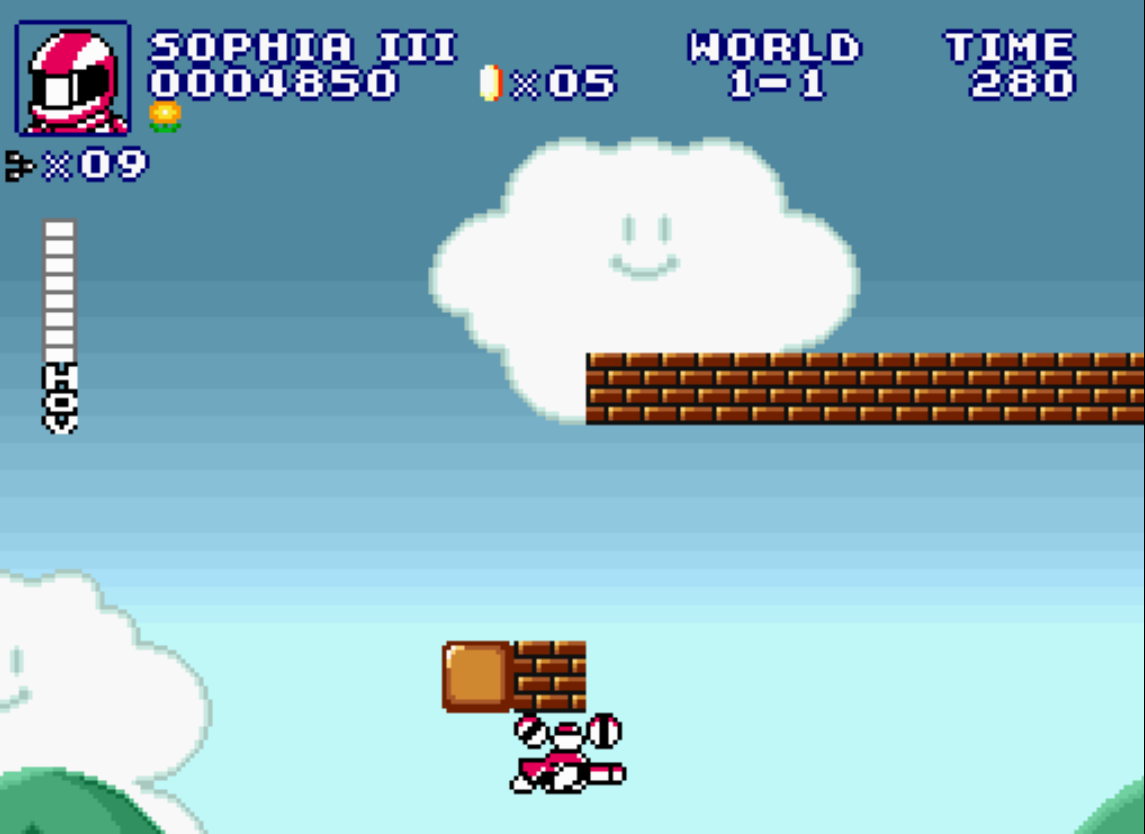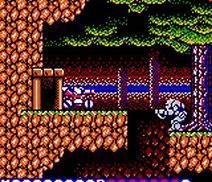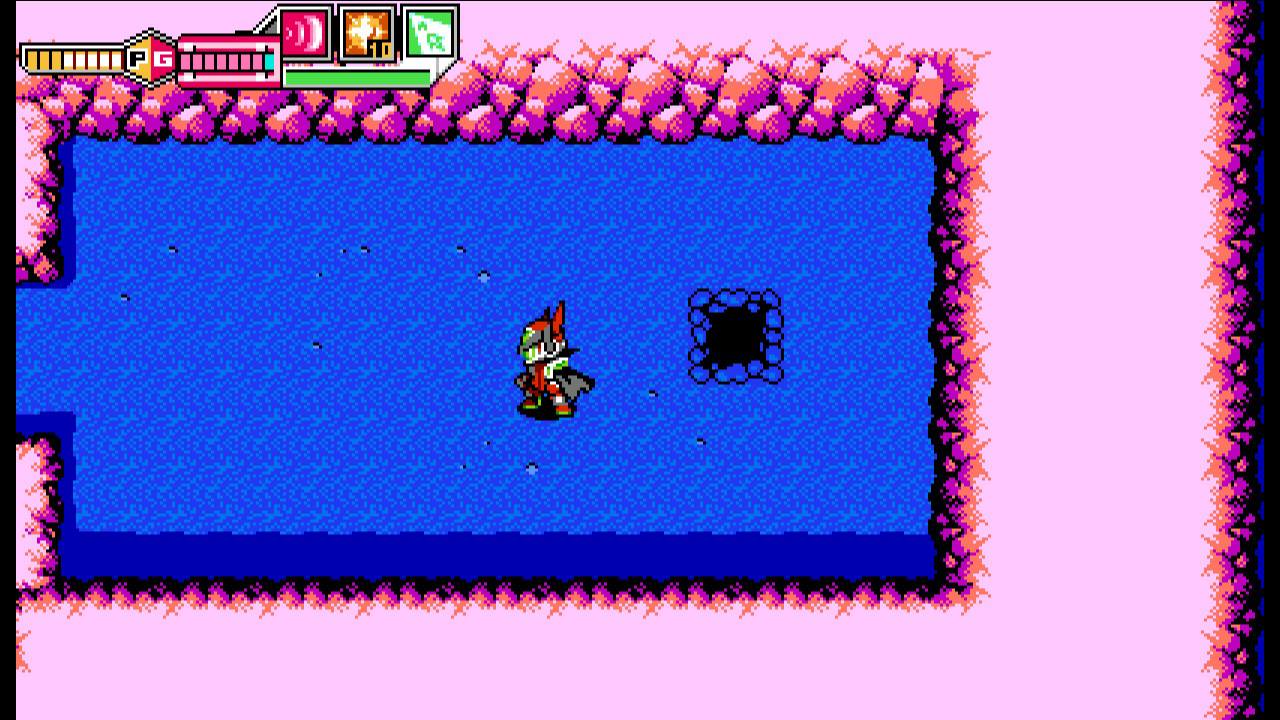Blaster Master is a series that started with a game that was originally released on NES in 1988. As this was, in fact, a year before I was born, I was not a fan of the series when it was originally released. The series continued to elude me despite receiving a smattering of low-key releases over the next two decades on systems which I, admittedly, did not have.
I was first exposed to Jason, the main character of Blaster Master, and his tank Sophia III in 2011 through a fan-made flash-based game called Super Mario Bros. Crossover. The basic premise of the game was that you play through the original Super Mario Bros. game using characters from various other series. As a long time gamer, I recognized most of the characters. Link and Samus were beloved Nintendo characters from my youth and I had also played many of the Castlevania titles, which Simon Belmont is from. I had played a bit of Contra in my day, so I recognized Bill Rizer and despite not having played their games, I was also familiar with Megaman and Ryu from Ninja Gaiden.
The sole character that I didn’t recognize was also the only vehicle, Jason’s Sophia III. Now, Super Mario Bros. was obviously designed with Mario sole stomp attack in mind, so characters that have different attacks absolutely shred their way through the levels. Characters possessing ranged attacks are especially powerful. Sophia III took an already powerful ranged attack and combined it with a superior and unique maneuverability. In addition to a decent jump and the ability to hover, Sophia III has the ability to attach to and drive up walls and onto ceilings. All of these things combined to make for some insanely fun gameplay, and so it was that Sophia III instantly became my favorite character.
At the end of 2011, it was announced that Blaster Master: Enemy Below, a Gameboy Color title from the year 2000 would be re-released for the Nintendo Virtual Console on 3DS. I bought the title immediately. It’s a pretty standard Metroidvania game and as such starts you off with a ship that lacks the gravity-defying wall-crawling abilities I so loved. As you progress, new abilities allow you to access new areas or find power-ups in areas you previously went through. One of the key differences between this and other titles is the ability to exit your ship and enter top-down dungeons.

The game is roughly split 50:50 between in-tank and on-foot gameplay, and most bosses are fought inside one of the on-foot dungeons. As was true of many games of the era, this game was really hard. Dying took you back to the last checkpoint, but the saves were handled with passwords. Luckily for me, the Virtual Console version included the ability to create and load restore points at any time. This modern save system made the game much easier than it otherwise would have; I probably wouldn’t have been able to complete it otherwise.

I would not be exposed to another iteration until Blaster Master Zero released in 2017, almost a week after the Nintendo Switch came out. At this early point in the console’s life, the Switch was hurting for games. And many early adopters, like myself, turned to smaller indie titles to fill the void. I had actually enjoyed playing Enemy Below on 3DS Virtual Console, so it wasn’t a difficult decision to get this game as well. Zero is a remake of the original title for NES, and this version improves upon both it and the Gameboy version in every way. The biggest thing is buttons; the NES and Gameboy both had only 2 main buttons (A and B), two menu buttons (start and select) and a D-pad for directional control. The Switch’s dual Joycons (or single Pro controller if you’re so inclined) have all the buttons of a modern system.
Whereas in the older games firing one of Sophia’s limited ammo special weapons required you to hold down and press B at the same time, in Zero, special weapons are given their own dedicated button. Another button lets you swap weapons on the fly, something that required you to go through the menu in the Gameboy version. Jason also gained the ability to strife in out of tank mode, which allows him to shoot in a direction that he isn’t moving, a valuable addition over the old games. The sprite based graphics are beautiful and give the game an SNES-style retro feel. As opposed to the Gameboy version’s password system, Zero uses a system where you only have to step on a save point in the game to activate it, though its lack of the Virtual Console’s restore points did add difficulty to the game.
Another nice thing is that because the game uses more primitive graphics than 3D games, it was much better on battery life than say Breath of the Wild. I must admit that I became pretty obsessed with the game. Over the next few months, the game continued to receive updates. Four new characters from other games were added as DLC. Each character would still drive in their own version of Sophia III, but have unique controls and abilities when outside of the tank. I enjoyed the game so much that I beat again with all but one of the DLC characters (I have thus far been unable to use Ekoro from Gun Gal’s skill set to beat the final boss).
Now a new Blaster Master game has released and it’s a direct sequel to Blaster Master Zero. Blaster Master Zero 2 (confusing name, I know) picks up its plot directly where the previous one leaves off. This time Jason has built a new ship, the G-Sophia, which is capable of spaceflight. He takes this ship from planet to planet clearing the mutant menace as he goes. The new ship can also now recharge its energy by falling. It’s a cool new mechanic, however it doesn’t amount to much in practice. Sophia can still recharge by picking up the dropped power-ups from enemies, so climbing before a drop generally feels like more trouble than it’s worth.
There’s also a penalty this time for running Sophia out of energy; all shots fired from the ship will be weaker until the ship recharges a short time later. You can kind of cheese this a little if there aren’t any enemies around to get a full energy charge, but generally there are more productive ways to fill the tank. Jason also has a brand new counter system that lets him issue a powerful counter whenever an enemy attacks. To make up for this formidable addition, or perhaps to encourage you to use it, all of Jason’s weapons are a bit weaker this time around. The higher level weapons still do a lot of damage, but there’s a bit of a cool-down which prevents you from just firing continuously.

The level design is just a good as the first entry. Each planet has a unique feel to it, however, I find each level to be a bit too small. The original felt like one big interconnected world, whereas this one feels like many small disjointed ones. It is possible that there are bigger levels later on that I haven’t gotten to yet. One of the major complaints I have is about fall damage. Jason obviously never takes damage from falls inside his tank in either game, and the dungeons are all top-down, so it’s not a problem their either.

There are a few occasions, however, where the game requires you to travel outside of Sophia in the side-scrolling over-world. In this view, Jason looks like a flea and is much more vulnerable to enemies than inside the tank. That is to be expected, however, if Jason falls more than half an inch, he takes damage and very likely dies. In a platformer, having that tight a tolerance with a character so small is very frustrating indeed.
I hate having to restart a segment from the last save point just because I fell a short distance off of a tiny ledge. Luckily, there aren’t too many of these kind of segments and most of the time Jason can just park Sophia right outside the dungeon. Ultimately, I’m really enjoying the game so far, though I would recommend any newcomers to the series to play through the first Zero game first.
Justin Hartline has a degree in Chemistry and puts his science knowledge to use as an investigator at a liquid coating company. His Dorky credentials include a love of Science Fiction (especially Star Wars), Fantasy (especially Game of Thrones), and superhero (especially Marvel) genres. He’s also a big fan of Nintendo games!
Contact: Twitter




